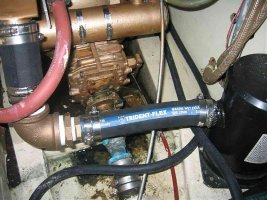No running hot anymore!!!
I had similar problems... my 5432 runs OK at 1800RPM (temp 195), starts to get hot at 1900RPM (210) and opening her up was not an option. Been this way for 2 years since I have owned her. Stdbtack came down to SD and helped me do the recommended H2O heater bypass modification and helped me acid out the heat exchanger but neither helped significantly. Over time, the problem is getting worse. Then, leaving for Catalina on Thurs, I can't keep up 1700RPM without hitting 210+. We turn around and spend Friday working on the problem. New raw water impeller, clean out filter, no improvement. Change thermostat... no improvement. Then I get the bright idea to check into the EYo forums and see what people say. I am ready to open up the fresh water pump when I remember about the mod of removing the flapper valve in the exhaust system. Jim at SD Marine Exchange thinks it may be the water/exhaust mixer being gouped up with salt from the excessive heat, but agrees this is an easier first try. I take out the old manifold, and I can hear the flapper flopping around in there... it's not attached, just rolling around. I make a new manifold, install and to go for yet another speed test. IT'S AWESOME!!!
1800rpm I hold 165-170
1950rpm 180deg
and wide open at 2200 for 30 mins it is stuck to 195.
I have never been able to open her up and it's great!!! Not that I'll spend much time there (the speed improvement is negligible) but it's nice to know I can.
Thanks all for your help... you guys rock. I am not around to contribute as much as I should for what I get out of the group (too much time wasted on Sailing Anarchy!) but I am glad I pitched in my $40 last year so I can at least sleep at night!!!!
Cheers,
jefe


